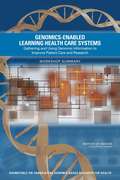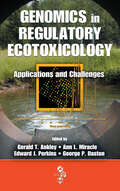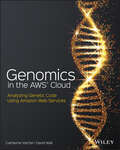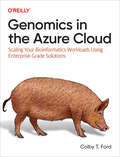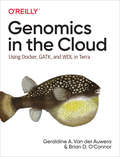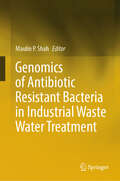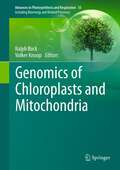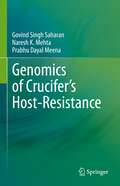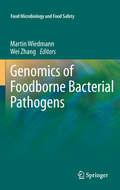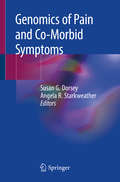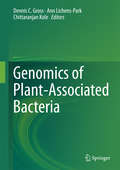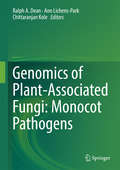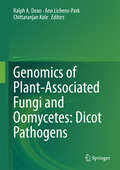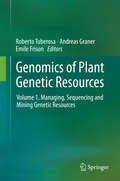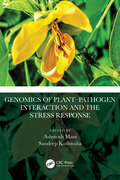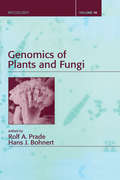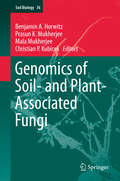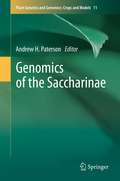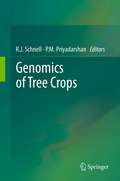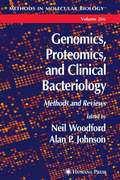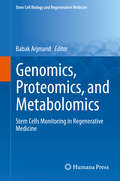- Table View
- List View
Genomics-Enabled Learning Health Care Systems: Workshop Summary
by Sarah H. BeachyThe inclusion of genomic data in a knowledge-generating health care system infrastructure is one promising way to harness the full potential of that information to provide better patient care. In such a system, clinical practice and research influence each other with the goal of improving the efficiency and effectiveness of disease prevention, diagnosis, and treatment. To examine pragmatic approaches to incorporating genomics in learning health care systems, the Institute of Medicine Roundtable on Translating Genomic-Based Research for Health hosted a workshop which convened a variety of stakeholder groups, including commercial developers, health information technology professionals, clinical providers, academic researchers, patient groups, and government and health system representatives, to present their perspectives and participate in discussions on maximizing the value that can be obtained from genomic information. The workshop examined how a variety of systems are capturing and making use of genomic data to generate knowledge for advancing health care in the 21st century. It also sought to evaluate the challenges, opportunities, and best practices for capturing or using genomic information in knowledge-generating health care systems. "Genomics-Enabled Learning Health Care Systems" summarizes the presentations and discussion of the workshop.
Genomics-Enabled Learning Health Care Systems: Workshop Summary
by Sarah H. BeachyThe inclusion of genomic data in a knowledge-generating health care system infrastructure is one promising way to harness the full potential of that information to provide better patient care. In such a system, clinical practice and research influence each other with the goal of improving the efficiency and effectiveness of disease prevention, diagnosis, and treatment. To examine pragmatic approaches to incorporating genomics in learning health care systems, the Institute of Medicine Roundtable on Translating Genomic-Based Research for Health hosted a workshop which convened a variety of stakeholder groups, including commercial developers, health information technology professionals, clinical providers, academic researchers, patient groups, and government and health system representatives, to present their perspectives and participate in discussions on maximizing the value that can be obtained from genomic information. The workshop examined how a variety of systems are capturing and making use of genomic data to generate knowledge for advancing health care in the 21st century. It also sought to evaluate the challenges, opportunities, and best practices for capturing or using genomic information in knowledge-generating health care systems. Genomics-Enabled Learning Health Care Systems summarizes the presentations and discussion of the workshop.
Genomics in Regulatory Ecotoxicology: Applications and Challenges
by Gerald T. Ankley Ann L. Miracle Edward J. Perkins George P. DastonFueled partially by large, well-publicized efforts such as the Human Genome Project, genomic research is a rapidly growing area in multiple biological disciplines, including toxicology. Much of this potential, however, has been discussed in the literature and at technical meetings only in relatively broad terms, making it difficult to assess exactl
Genomics in the AWS Cloud: Analyzing Genetic Code Using Amazon Web Services
by David Wall Catherine VacherPerform genome analysis and sequencing of data with Amazon Web Services Genomics in the AWS Cloud: Analyzing Genetic Code Using Amazon Web Services enables a person who has moderate familiarity with AWS Cloud to perform full genome analysis and research. Using the information in this book, you'll be able to take a FASTQ file containing raw data from a lab or a BAM file from a service provider and perform genome analysis on it. You'll also be able to identify potentially pathogenic gene sequences. Get an introduction to Whole Genome Sequencing (WGS) Make sense of WGS on AWS Master AWS services for genome analysis Some key advantages of using AWS for genomic analysis is to help researchers utilize a wide choice of compute services that can process diverse datasets in analysis pipelines. Genomic sequencers that generate raw data files are located in labs on premises and AWS provides solutions to make it easy for customers to transfer these files to AWS reliably and securely. Storing Genomics and Medical (e.g., imaging) data at different stages requires enormous storage in a cost-effective manner. Amazon Simple Storage Service (Amazon S3), Amazon Glacier, and Amazon Elastics Block Store (Amazon EBS) provide the necessary solutions to securely store, manage, and scale genomic file storage. Moreover, the storage services can interface with various compute services from AWS to process these files. Whether you're just getting started or have already been analyzing genomics data using the AWS Cloud, this book provides you with the information you need in order to use AWS services and features in the ways that will make the most sense for your genomic research.
Genomics in the Azure Cloud: Scaling Your Bioinformatics Workloads Using Enterprise-Grade Solutions
by Colby T. FordThis practical guide bridges the gap between general cloud computing architecture in Microsoft Azure and scientific computing for bioinformatics and genomics. You'll get a solid understanding of the architecture patterns and services that are offered in Azure and how they might be used in your bioinformatics practice. You'll get code examples that you can reuse for your specific needs. And you'll get plenty of concrete examples to illustrate how a given service is used in a bioinformatics context.You'll also get valuable advice on how to:Use enterprise platform services to easily scale your bioinformatics workloadsOrganize, query, and analyze genomic data at scaleBuild a genomics data lake and accompanying data warehouseUse Azure Machine Learning to scale your model training, track model performance, and deploy winning modelsOrchestrate and automate processing pipelines using Azure Data Factory and DatabricksCloudify your organization's existing bioinformatics pipelines by moving your workflows to Azure high-performance compute servicesAnd more
Genomics in the Cloud: Using Docker, GATK, and WDL in Terra
by Geraldine A. Van der Auwera Brian D. O'ConnorData in the genomics field is booming. In just a few years, organizations such as the National Institutes of Health (NIH) will host 50+ petabytesâ??or over 50 million gigabytesâ??of genomic data, and theyâ??re turning to cloud infrastructure to make that data available to the research community. How do you adapt analysis tools and protocols to access and analyze that volume of data in the cloud?With this practical book, researchers will learn how to work with genomics algorithms using open source tools including the Genome Analysis Toolkit (GATK), Docker, WDL, and Terra. Geraldine Van der Auwera, longtime custodian of the GATK user community, and Brian Oâ??Connor of the UC Santa Cruz Genomics Institute, guide you through the process. Youâ??ll learn by working with real data and genomics algorithms from the field.This book covers:Essential genomics and computing technology backgroundBasic cloud computing operationsGetting started with GATK, plus three major GATK Best Practices pipelinesAutomating analysis with scripted workflows using WDL and CromwellScaling up workflow execution in the cloud, including parallelization and cost optimizationInteractive analysis in the cloud using Jupyter notebooksSecure collaboration and computational reproducibility using Terra
Genomics of Antibiotic Resistant Bacteria in Industrial Waste Water Treatment
by Maulin P. ShahThis book discusses the key problems and solutions with various applicable approaches to combat antibiotic-resistant genes in industrial waste water. Several genes are selected within the chapters to illustrate the past and future roles of molecular ecophysiology and genomics in the development of wastewater microbiology as an important subdiscipline of microbial ecology. As we have very limited knowledge of composition, dynamics and stability of microbial communities, various processes in wastewater treatment have been generally considered to be "black box." In recent years, with the development of several new high throughput sequencing platforms, metagenome sequencing strategies and bioinformatics toolboxes, the analysis of the genome of complex communities has become much more accessible and means easier.The opening of the biological wastewater treatment “black box” is not the unpleasant experience it was before. The viable, but not cultural, ceases to be the inconsequential, uncharacterizable enigma that existed today. Metagenomics leads the way for more specific studies in related fields. Finally, genomic studies of wastewater treatment microbes, in addition to their biotechnological applications, are also an excellent testing ground for variety of other ecological and environmental burns questions. Wastewater treatment plants are considered hotspots for the environmental dissemination of antimicrobial-resistant determinants. Comparative genomics of antibiotic resistant genes isolated from conventional activated sludge and biological aerated filter wastewater treatment plants is discussed.
Genomics of Chloroplasts and Mitochondria
by Ralph Bock Volker KnoopThe past decade has witnessed an explosion of our knowledge on the structure, coding capacity and evolution of the genomes of the two DNA-containing cell organelles in plants: chloroplasts (plastids) and mitochondria. Comparative genomics analyses have provided new insights into the origin of organelles by endosymbioses and uncovered an enormous evolutionary dynamics of organellar genomes. In addition, they have greatly helped to clarify phylogenetic relationships, especially in algae and early land plants with limited morphological and anatomical diversity. This book, written by leading experts, summarizes our current knowledge about plastid and mitochondrial genomes in all major groups of algae and land plants. It also includes chapters on endosymbioses, plastid and mitochondrial mutants, gene expression profiling and methods for organelle transformation. The book is designed for students and researchers in plant molecular biology, taxonomy, biotechnology and evolutionary biology.
Genomics of Crucifer's Host- Pathosystem
by Govind Singh Saharan Naresh K. Mehta Prabhu Dayal MeenaThe book deals with latest research achievements of Brassica scientists using omics approaches in understanding host-pathogen interaction, molecular detection, identification, and functional characterization of effectors/genes including pathogenomics and biometabolomics. Genomics of host-pathogen interaction is a source of information for the teachers, students, researchers, and policy makers to foster success in enhancing the Brassica production and productivity through the development of improved disease-resistant varieties with the use of omics technologies. It is a base and sound plate form for managing biological stresses of Brassica at global level. The book covers up-to-date information on genomics of host-pathogen interaction, pathogenomics of crucifers’ pathogen, and biometabolomics of host pathosystem supplemented with ample photographs, illustrations, and figures which make it stimulating, effective, and easy to comprehend for readers, researchers, biology students, teachers, and policy makers.
Genomics of Crucifer’s Host-Resistance
by Govind Singh Saharan Prabhu Dayal Meena Naresh K. MehtaThe book presents comprehensive information on fundamental, and applied knowledge for developing varieties resistant individually as well as to all the major pathogens of crucifers, such as Albugo, Alternaria, Erysiphe, Hyaloperonospora, Plasmodiophora, Leptosphaeria, Sclerotinia, Turnip mosaic virus, Verticillium, and Xanthomonas through the use of latest biotechnological approaches including identification of R genes and their incorporation into agronomically superior varieties. The chapters include the information’s viz., principles of host resistance, identification of R-genes sources, inheritance of disease resistance, host resistance signaling network system to multiple stresses. The book also covers transfer of disease resistance, and management of disease resistance. Standardized, reproducible techniques are also included for the researchers of cruciferous crops for developing resistant cultivars. The book deals with the gaps in understanding, knowledge of genomics, and offers suggestions for future research priorities in order to initiate the advance research on disease resistance. This book is immensely useful to the researchers especially Brassica breeders, teachers, extension specialists, students, industrialists, farmers, and all others who are interested to grow healthy, and profitable cruciferous crops all over the world.
Genomics of Foodborne Bacterial Pathogens
by Martin Wiedmann Wei ZhangFoodborne illnesses caused by various bacterial, viral, and fungal pathogens lead to a high number of morbidity and mortality in the U.S. and throughout the world. Recent advances in microbial genomics have significantly improved our understanding of the physiology, evolution, ecology, epidemiology, and pathogenesis of different foodborne pathogens. This book focuses on the genomics of foodborne bacterial pathogens. It begins with a brief overview of the recent advances in microbial genomics and the impact of genomics on food safety research. Then, eight chapters follow that elaborate some in-depth reviews on the genomics of several common foodborne bacterial pathogens including Bacillus, Campylobacter, Clostridium, Escherichia coli, Listeria, Salmonella, Staphylococcus, and Vibrio. Finally, the last four chapters focus on some current genomic, transcriptomic, and proteomic technologies and their applications in studying the epidemiology, evolution, and pathogenesis of foodborne bacterial pathogens. Genomics of Foodborne Bacterial Pathogens can be used as a reference by scientists and professionals in academia, government, and industry who are interested in understanding microbial genomics and using genomics tools to study foodborne bacterial pathogens. This book can also be used as a textbook for instructors and professors who teach food microbiology or microbial genomics-related courses at the post-graduate level.
Genomics of Pain and Co-Morbid Symptoms
by Susan G. Dorsey Angela R. StarkweatherThis book provides an overview of the field of pain genomics and the genomics of related, or co-occuring, symptoms, the current state-of-the-science, and challenges that remain. It brings differing views in the field together and provides examples of translational science from using cellular and rodent models to human clinical trials. This book's structure leads the reader through the physiology of pain and genomics into how pain is studied, mechanisms of acute and chronic pain, various protocols that are used throughout the field along with the pros/cons of the current methods used, and project into the future of pain genomics. This work is intended for classroom teaching, for nurses, for novice researchers in symptom science and pain research as well as students and postdoctoral fellows.
Genomics of Pattern Recognition Receptors: Applications in Oncology and Cardiovascular Diseases
by Anton G. Kutikhin Arseniy E. YuzhalinThis book offers comprehensive information on the polymorphisms of genes encoding pattern recognition receptors (PRRs). Following a short description of the general role of PRRs in the immune system, the structure and function of Toll-like and NOD-like receptors are examined in detail. The main focus is on the role of inherited variation in PRRs and their correlation to cancer and cardiovascular diseases. A review of all epidemiological investigations is included, and a concept of genomic risk markers for the prevention of various diseases is also discussed.
Genomics of Plant-Associated Bacteria
by Dennis C. Gross Ann Lichens-Park Chittaranjan KoleThis book describes how genomics has revolutionized our scientific understanding of agriculturally important plant-associated bacteria. Each chapter focuses on the genomics of particular bacteria: the first described plant pathogen, Erwinia amylovora; phytoplasmas lacking cell walls; fastidious, phloem-restricted liberibacters; Pseudomonas syringae, which is a genetically tractable model system; Xanthomonas citri, which causes a disease that can devastate citrus crops and Pseudomonas fluorescens, which can protect plants from diseases. Topics considered in this volume include the importance of horizontal gene transfer in originating new bacterial strains and species and advances in transcriptomics that allow us to describe the complex regulatory networks critical to plant-microbe interactions. The availability of the Xanthomonas oryzae genome has led to new technologies in genome editing, which will revolutionize approaches to genetic engineering, even in eukaryotes. The contributions show how genomics has greatly accelerated progress toward understanding the biology of these bacteria and how that understanding can be translated into novel crop protection methods.
Genomics of Plant-Associated Fungi: Monocot Pathogens
by Ralph A. Dean Ann Lichens-Park Chittaranjan KoleThis book describes how genomics has revolutionized our understanding of agriculturally important plant-associated fungi. It illustrates some fundamental discoveries about these eukaryotic microbes with regard to the overall structure of their genomes, their lifestyles and the molecular mechanisms that form the basis of their interactions with plants. Genomics has provided new insights into fungal lifestyles and led to practical advances in plant breeding and crop protection, such as predictions about the spread and evolution of new pathogens. This volume focuses on fungi that are important cereal and other monocot plant pathogens and includes: Pyrenophora tritici-repentis, Cochliobolus sp. , Colletotrichum sp. , Fusarium graminearum, Mycosphaerella graminicola and Mycosphaerella fijiensis, Magnaporthe oryzae, Blumeria graminis and Puccinia graminis.
Genomics of Plant-Associated Fungi and Oomycetes: Dicot Pathogens
by Ralph A. Dean Ann Lichens-Park Chittaranjan KoleThis book describes how genomics has revolutionized our understanding of agriculturally important plant-associated fungi and oomycetes. It illustrates some fundamental discoveries about these eukaryotic microbes with regard to the overall structure of their genomes, their lifestyles and the molecular mechanisms that form the basis of their interactions with plants. Genomics has provided new insights into fungal lifestyles and led to practical advances in plant breeding and crop protection, such as predictions about the spread and evolution of new pathogens. This volume focuses on fungi and oomycetes that are typical dicot plant pathogens and includes: Sclerotinia sclerotiorum, Botrytis cinerea, Alternaria sp. ,Verticillium alfalfae and Verticillium dahliae, Fusarium oxysporum, Phytophthora capsici, Phytophthora sojae, Phytophthora ramorum, Phytophthora infestans, Hyaloperonospora arabidopsidis.
Genomics of Plant Genetic Resources
by Emile Frison Andreas Graner Roberto TuberosaOur lives and well being intimately depend on the exploitation of the plant genetic resources available to our breeding programs. Therefore, more extensive exploration and effective exploitation of plant genetic resources are essential prerequisites for the release of improved cultivars. Accordingly, the remarkable progress in genomics approaches and more recently in sequencing and bioinformatics offers unprecedented opportunities for mining germplasm collections, mapping and cloning loci of interest, identifying novel alleles and deploying them for breeding purposes. This book collects 48 highly interdisciplinary articles describing how genomics improves our capacity to characterize and harness natural and artificially induced variation in order to boost crop productivity and provide consumers with high-quality food. This book will be an invaluable reference for all those interested in managing, mining and harnessing the genetic richness of plant genetic resources.
Genomics of Plant–Pathogen Interaction and the Stress Response
by Ashutosh Mani Sandeep KushwahaPlants are an indispensable part of human and animal lives for nutrition and health. But pests, diseases and abiotic stress adversely affect crop yield, which ultimately places significant pressure on society to provide food to an increasing population. Moreover, it also encourages increased chemical/pesticide usage on crops, which we see in the biomagnification of toxic and hazardous compounds polluting water bodies, soil and the environment. This condition will continue to worsen in the future due to the resistance-acquiring ability of pathogens against plant defense and chemical treatments. In addition, environmental disturbances and consumer health issues are being reported more promptly than before due to intensive use of pesticides in food production. Plant diseases affect our daily lives, as the use of insecticides and pesticides has become part of our food chain. As a result, precise disease diagnosis and management is crucial in order to avoid huge losses in plant production and related commodities. Accurate detection, precise diagnosis and proper management can play a significant role in keeping plants free from pathogens. In this book, scientists, researchers and scholars share their research knowledge, offering a valuable resource for understanding plant diseases, pathogen interaction and responses to stress through an omics perspective, contributing to further advancements in the field Diseases in plants may be caused by various factors, such as viruses, bacteria, fungi and abiotic stress. Disease causes low crop yield, production of poor-quality fruits and grains, and deficiency of nutrients, which have a direct impact on human and animal health. A genomics-based approach can be applied to disease diagnosis; disease outbreak; evolution of plant and pathogen genome for disease outbreak in relation to climate change; and development of long-term strategies for plant health and defense. This book presents an overview of omics technologies and approaches used to understand: 1) the relation between plants and their environment in terms of diseases 2) responses to abiotic stress 3) the genomics of plant–pathogen interaction 4) herbicide-resistance mechanisms 5) the epigenetics of plant–pathogen interaction 6) gene regulation during abiotic stress response 7) the oxidative stress response
Genomics of Plants and Fungi
by Hans J. Bohnert Rolf A. PradeThis volume provides technical insight on how genomics-oriented studies may be used to bring new understanding to established models of fungal development. The book helps to assess and solve problems associated with multiple copies of genes and proteins with seemingly identical functions and depicts various industrial applications. To bridge the in
Genomics of Soil- and Plant-Associated Fungi
by Mala Mukherjee Prasun K. Mukherjee Benjamin A. Horwitz Christian P. KubicekThis volume addresses the similarities and also the differences in the genomes of soil saprophytes, symbionts, and plant pathogens by using examples of fungal species to illustrate particular principles. It analyzes how the specific interactions with the hosts and the influence of the environment may have shaped genome evolution. The relevance of fungal genetic research and biotechnological applications is shown for areas such as plant pathogenesis, biomass degradation, litter decomposition, nitrogen assimilation, antibiotic production, mycoparasitism, energy, ecology, and also for soil fungi turning to human pathogens. In addition to the model organisms Neurospora and Aspergillus, the following species are covered providing a view of pathogens and mutualists: Trichoderma, Fusarium oxysporum, Cochliobolus heterostrophus, Penicillium chrysogenum, Rhizopus oryzae, Podospora anserina, Agaricomycetes, Archaeorhizomycetes and Magnaporthaceae. Ecology and potential applications have guided the choice of fungal genes to be studied and it will be fascinating to follow the trends of future sequencing projects.
Genomics of the Saccharinae
by Andrew H. PatersonThe Saccharinae clade of the Poaceae (grass) family of flowering plants includes several important crops with a rich history of contributions to humanity and the promise of still-greater contributions, as a result of some of the highest biomass productivity levels known, resilience to drought and other environmental challenges that are likely to increase, amenability to production systems that may mitigate or even reverse losses of ecological capital such as topsoil erosion, and the recent blossoming of sorghum as a botanical and genomic model for the clade. In Genomics of the Saccharinae, advances of the past decade and earlier are summarized and synthesized to elucidate the current state of knowledge of the structure, function, and evolution of the Sorghum, Saccharum, and Miscanthus genera, and progress in the application of this knowledge to crop improvement. As a backdrop, it is important to understand the naturally occurring diversity in each genus, its organization and distribution, and its evolutionary history. Genomic tools and methods for Saccharinae biology and improvement have improved dramatically in the past few years - a detailed summary of these tools and their applications is a central element of this book. Application of genomic tools to priorities in crop improvement, including understanding and manipulating plant growth and development, composition, and defense, as well as increasing the quality and productivity of seed/grain, sugar, biomass, and other value-added products under a range of conditions and inputs, are addressed. In particular, as the first native African crop to emerge as a genomic model, sorghum offers an excellent case study of challenges and opportunities in linking new advances in biosciences to solving some of Africa's major agricultural problems. Several members of the clade, exemplified by Sorghum halepense (Johnsongrass) offer insights into weediness and invasion biology. The first sequence for a member of the clade, sorghum, as well as progress and challenges toward sequencing of additional members and the new opportunities that this will create, are also explored. Indeed, the very complexities that have hindered study of some clade members also offer intriguing opportunities to gain insight into fundamental questions such as roles of polyploidy in agricultural productivity and post-polyploidy evolution.
Genomics of Tree Crops
by R. J. Schnell P. M. PriyadarshanTrees that are indispensably supportive to human life pose a formidable challenge to breed them to suit to human needs. From soft drinks to breweries to beverages to oil to tires, the value added products from trees give a spectrum of products to human kind. While attempts to tap these resources through conventional breeding are underway, the quick and elegant way of manipulating the genetic systems at the genome level is an essential chapter of modern science. Books featuring genomics of tree crops are few, and genomics is such a science that changes rapidly. Genomics of Tree Crops is an earnest attempt towards compiling genomics of tree crops. Plant genomics has made monumental strides in the last decade providing insights into intra-genomic phenomena such as heterosis, epistasis, pleiotropy and other interactions between loci and alleles within the genome. In contrast, the investigation of the roles and functions of single genes is a primary focus of molecular biology and is a common topic of modern genetic research. A genome is the sum total of all of an individual organism's genes. Thus, genomics is the study of all the genes of a cell, or tissue, at the DNA (genotype), mRNA (transcriptome), or protein (proteome) levels. The complete sequencing of the three billion base pair human genome with 25,000 genes identified and the invention of DNA microarrays ushered in a new era in the science of genomics leading to explosive advancements in oncology diagnostics. This impetus into the genomics era lead the way toward advances in plant genomics which started with Arabidopsis thaliana and went through an array of crops such as rice, maize, papaya, various cereals and legumes, with pigeon pea added to the list towards the end of 2011. Trees, on the other hand, are the least attended taxa with regard to genomic research. Some of the areas that attained attention of the scientists are: DNA sequencing, bioinformatics, genomics of flowering, gene flow, spatial structure, local adaptation and assisted migration in trees, transformation of fruit trees, genomics of tropical and temperate fruit trees, genomics of Hevea rubber, genomics of papaya and genomics of palms. Genomics of Tree Crops compiles this information with chapters authored by experts on these crops.
Genomics, Personalized Medicine and Oral Disease
by Stephen T. Sonis Dmd DmscThe objective of this book is to catalyze the application of genomics to the diagnosis and treatment of oral diseases by comprehensively presenting focused discussions on the current state of knowledge. The first section book provides basic information about genetics, genomics and personalized medicine and the informatical methods available to apply and organize genetic data so that it has clinical relevance. Recognizing the genetic robustness of the oral cavity, the introductory section includes chapters on the oral micro biome and host genomics and response to infectious agents. The next two sections contain chapters which describe the genomics of specific oral diseases and conditions, including the genetic basis for mechanism and risk of treatment toxicities associated with cancer therapy and bisphosphonates. Four chapters focus on gene-based therapies and the pharmacogenomics applied to oral disease. The final chapter presents a provocative summary which describes a comprehensive vision of the melding of genomics to personalized medicine and the potential actionable outcomes that will likely affect clinical practice in the upcoming years.
Genomics, Proteomics, and Clinical Bacteriology
by Alan P. Johnson Neil WoodfordAn accessible introduction to how genomics has and will provide novel methods for bacterial investigation and advance our understanding and knowledge of bacterial pathogenicity. The authors critically evaluate the applications of genomics to diagnostic bacteriology, highlighting both current and likely future uses, describing real-time PCR methods, and outlining the promise of microarrays in clinical bacteriology. Their discussion examines in detail genomic approaches to antibacterial discovery, the nature of pathogenicity, the discovery of new pathogens, the exploration of the concept of clonality in bacteria, and bacterial taxonomics.
Genomics, Proteomics, and Metabolomics: Stem Cells Monitoring in Regenerative Medicine (Stem Cell Biology and Regenerative Medicine)
by Babak ArjmandThis book provides thorough coverage of high-throughput OMICs technologies for the monitoring of stem cells and regenerative medicine. Specific topics covered include the genomics, proteomics, and metabolomics aspects of regenerative medicine, metabolic profiling of mesenchymal stem cells, genome profiling of mesenchymal stem cells, OMICs monitoring of stem cell-derived exosomes, stem cell proteomics, lipidomics, OMICs profiling of cancer (stem) cells, and finally ethical considerations of OMICs-based investigations. Chapters are authored by world-renowned scientists who have valuable expertise in the field of OMICs and regenerative medicine.Genomics, Proteomics, and Metabolomics: Stem Cells Monitoring in Regenerative Medicine, part of Springer’s Stem Cell Biology and Regenerative Medicine series, is essential reading for researchers, clinicians, biologists, biochemists, and pharmaceutical experts conducting research in the fields of stem cell biology, molecular aspects of stem cell research, tissue engineering, regenerative medicine, cellular therapy, OMICs, bioinformatics, and ethics.
